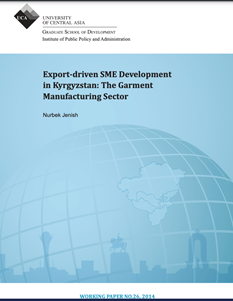Export-driven SME Development in Kyrgyzstan: The Garment Manufacturing Sector
This paper examines recent developments in the garment production sector in Kyrgyzstan that contributes significantly to GDP and employment.
The paper analyses the factors that led to the impressive growth of garment manufacturing. The export volume of Kyrgyz clothing to the Russian Federation and Kazakhstan increased ten-fold from 2002 to 2012. The main reasons for this growth include open trade regime and simplified weight-based customs clearance, which allowed for relatively cheap acquisition of fabrics; favourable patent-based tax treatment; and the solid entrepreneurial skills of Kyrgyz entrepreneurs.
In-depth interviews were conducted with garment manufacturers and wholesale order customers and informed a profile of the structure and workings of the garment industry. This study also examines the impact of recent policy changes, including import tariff increases on fabrics and clothing accessories, as well as the possible implications of Customs Union accession by Kyrgyzstan on its garment production sector.
Other key findings can be summarised as follows: (i) 2013 saw a decline in demand for Kyrgyz clothing in key markets of the Russian Federation and Kazakhstan, likely due to: import tariff increases, resultant decreases in imported Chinese fabrics and increased production costs; and a shift in preferences from Kyrgyz to Belarusian apparel, which is perceived as the closest competitor to Kyrgyz clothing; (ii) The production cost of clothing would increase by 10 to 20 percent after the country enters the Customs Union. Kyrgyz products would be still cheaper than Belarusian counterparts but the price differential would decrease. This, combined with enormous support of the Belarusian government to its clothing sector, may result in Kyrgyz products losing some of its middle-class customers in the Russian Federation and Kazakhstan.








